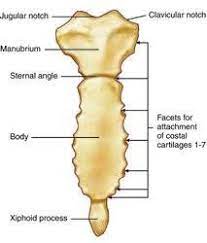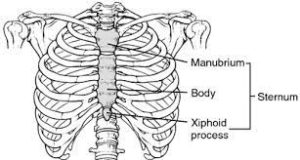
 The sternum or breastbone.
The sternum or breastbone.
It is a long flat bone located in the central part of the chest.
It is a narrow, flat bone, forming the middle portion of the front of the chest.
It connects to the ribs via cartilage and forms the front of the rib cage.
The sternum helps to protect the heart, lungs, and major blood vessels from injury.
Shaped roughly like a necktie.
It is one of the largest and longest flat bones of the body.
It has three regions: the manubrium, the body, and the xiphoid process.
The top of the sternum supports the clavicles and its edges join with the costal cartilages of the first two pairs of ribs.
The inner surface of the sternum is also the attachment of the sternopericardial ligaments.
The eternal top is also connected to the sternocleidomastoid muscle.
The sternum consists of three main parts, listed from the top:
Manubrium
Body
Xiphoid process
The sternum is angled obliquely, downward and forward.
It is slightly convex in front and concave behind and broad above.
It is shaped like a T, becoming narrowed at the point where the manubrium joins the body, after which it again widens a little to below the middle of the body, and then narrows to its lower extremity.
In adults the sternum is on average about 17 cm.
The sternum is longer in the male than in the female.
The manubrium is the broad upper part of the sternum.
It has a quadrangular shape.
It narrows from the top, which gives it four borders.
The suprasternal notch or jugular notch is located in the middle at the upper broadest part of the manubrium.
On either side of this notch are the right and left clavicular notches.
The manubrium joins with the body of the sternum, the clavicles and the cartilages of the first pair of ribs.
Its inferior border,is covered with a thin layer of cartilage for articulation with the body.
The lateral borders of the manubrium are each marked above by a depression for the first costal cartilage and for the reception of the costal cartilage of the second rib.
The superior sternopericardial ligament attaches the pericardium to the posterior side of the manubrium.
The body of the sternum the longest sternal part.
It is flat and considered to have only a front and back surface.
Upward and forward, and marked by three transverse ridges which cross the bone opposite the third, fourth, and fifth articular depressions.
The pectoralis major attaches to the body on either side.
The sternal angle is located at the point where the body joins the manubrium.
The sternal angle is a useful landmark because the second rib attaches here.
Each outer border forms a cavity for the cartilage of the second rib; below this are four angular depressions which receive the cartilages of the third, fourth, fifth, and sixth ribs.
The inferior angle has a small facet, which forms a notch for the cartilage of the seventh rib.
The upper border is oval and articulates with the manubrium, at the sternal angle.
The lower border is narrow, and articulates with the xiphoid process.
The Xiphoid process is located at the inferior end of the sternum.
It is the pointed end of the sternum.
The sternum is composed of highly vascular tissue, covered by a thin layer of compact bone which is thickest in the manubrium between the articular facets for the clavicles.
The inferior sternopericardial ligament attaches the pericardium to the posterior xiphoid process.
The cartilages of the top five ribs join with the sternum at the sternocostal joints.
The right and left clavicular notches articulate with the right and left clavicles, respectively.
The costal cartilage of the second rib articulates with the sternum at the sternal angle making it easy to locate.
The transversus thoracis muscle is innervated by one of the intercostal nerves and superiorly attaches at the posterior surface of the lower sternum.
The transversus thoracis muscle inferior attachment is the internal surface of costal cartilages two through six and works to depress the ribs.
In 2.5–13.5% of the population, a foramen known as sternal foramen may be presented at the lower third of the sternal body.
The sternum contains bone marrow, and is sometimes used as a site for bone marrow biopsy.
The sternal foramen, a single round hole in the sternum that is present from birth and usually is off-centered to the right or left, commonly forming in the 2nd, 3rd, and 4th segments of the breastbone body.
Fractures of the sternum may result from trauma, such as a car accident.
Sternal fractures are usually a comminuted fracture.
The most common site of sternal fractures is at the sternal angle.
Sternal fractures are frequently associated with underlying injuries such as pulmonary contusions.
A sternal dislocation is rare and usually caused by severe trauma.
A sternal dislocation may result from minor trauma where there is a precondition of arthritis.
A median sternotomy allows access to the thoracic contents when performing cardiothoracic surgery.
The sternum can be totally resected) as part of a radical surgery, usually to treat a malignancy.
A bifid sternum is an extremely rare congenital abnormality caused by the fusion failure of the sternum.
